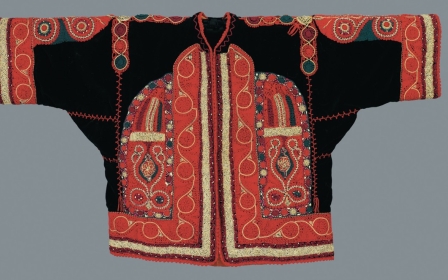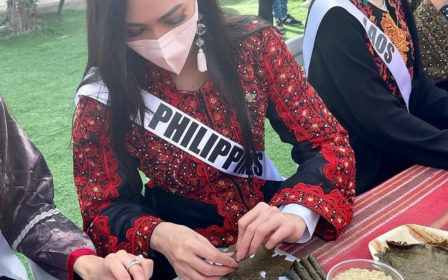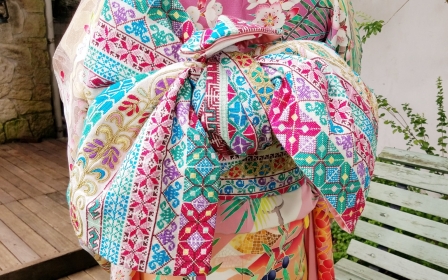#MyHistoricalThobe: Online movement celebrates Palestinian heritage

Hundreds of Palestinian women have flooded social media platforms with pictures of their intricately embroidered Palestinian thobes (dresses) as part of a new online campaign to highlight and protect the tradition.
The campaign, launched on 17 February by Falastini TV, a Palestine-based channel dedicated to arts and culture, was designed to shed light on Palestinian heritage as well as educate people on its origins.
'Many Palestinians consider the thobe as a heritage, as a weapon in which they defend their history and identity, and that’s why stealing it is like stealing their whole lives'
- Sumaya Souqi, Falastini TV
Palestinian thobes, and the tatreez style of embroidery used to add detail to them, are around 3,000 years old, and are seen as intrinsic to Palestinian culture and identity.
A number of hashtags have been used to share images of people in their thobes, including #MyHistoricalThobe, #PalestinianEmbroidery and #OurHeritageIsNotForStealing. The hashtags were shared in both English and Arabic.
Sumaya Souqi, the senior marketing communications specialist at Falastini TV, highlighted the importance of the campaign.
New MEE newsletter: Jerusalem Dispatch
Sign up to get the latest insights and analysis on Israel-Palestine, alongside Turkey Unpacked and other MEE newsletters
“The Palestinian thobe has always been woven by Palestinian women, documenting the Palestinian heritage and presence on silk and velvet fabrics. The Palestinian thobe reflects the history, civilisation, authenticity and heritage of the beloved Palestine,” she told Middle East Eye.
“Many Palestinians consider the thobe as a heritage, as a weapon in which they defend their history and identity, and that’s why stealing it is like stealing their whole lives,” she added, referencing the appropriation of the thobe throughout history.
Examples of this, according to Souqi, include the Israeli Minister of Culture Miri Regev wearing a dress bearing the image of the Old City of Jerusalem, al-Aqsa Mosque and the Dome of the Rock.
According to Souqi, the campaign was successful, and received a great deal of feedback and engagement from supporters online.
The campaign was also used as a form of solidarity amidst escalating tensions in the occupied east Jerusalem neighbourhood of Sheikh Jarrah, where a number of Palestinian families are facing expulsion from their homes.
Earlier this month, the neighbourhood experienced several nights of violent Israeli police assaults while they attempted to disperse Palestinian residents in the area.
Among those who participated in the campaign is Palestinian activist Muna el-Kurd, who has risen as a prominent spokesperson through documenting assaults against her family’s home in Sheikh Jarrah, as well as attacks on other families in the neighbourhood, on social media.
Using her Instagram stories, the activist posted a series of photos of herself in a vibrant, hand-stitched red and black thobe, with the caption "my thobe is Palestinian and will remain Palestinian".
In another photo posted, el-Kurd encouraged others to take part in the campaign.
History of appropriation
One of the main intentions behind the campaign was to shed light on the long history of appropriation of the Palestinian thobe as well as educate people on the rich Palestinian culture.
Last year, Miss Universe contestants came under fire after photos circulated of them participating in a "visit Israel" campaign while wearing traditional Palestinian thobes.
In a series of photos uploaded by Miss Philippines Beatrice Gomez, the contestants were seen wearing the dresses while rolling grape-vine leaves, and claiming to experience Israeli culture in the Red Sea city of Eilat.
The city of Eilat was built upon the ruins of a small Palestinian fishing town of Umm al-Rashrash during the Nakba, when almost 750,000 Palestinians were expelled from their towns and villages by Zionist militias in 1948.
Many social media users criticised the contestants, stating it was an example of “erasure of indigenous existence” and “promotion of the occupation forces using cultural appropriation”.
Unesco protected tradition
Last year, Unesco added Palestinian embroidery to its Intangible Cultural Heritage List. The tradition of embroidery, known as tatreez, is the art of hand stitching patterns and motifs with brightly coloured thread onto clothing.
At the time, Palestinian Authority (PA) Prime Minister Mohammad Shtayyeh thanked Unesco for its inclusion of the tradition, calling it an important and timely step.
Embroidered motifs and colours vary from one area to another, reflecting the unique characteristics of Palestinian villages and towns. Each town has its own style of patterns and uses a bespoke collection of threads for use in tatreez.
Palestinians trace their embroidery practices, as well as their thobes, back to ancient Canaanite and Phoenician forebears.
Since the 1967 war and Israel's subsequent occupation of East Jerusalem, the West Bank and Gaza Strip, embroidery practices have been revived among Palestinian refugees to emphasise their political and national identity.
“Embroidery is a social and intergenerational practice, as women gather in each other’s homes to practise embroidery and sewing, often with their daughters," the Unesco statement said.
Previous campaigns
This is not the first time such a campaign has been launched.
In 2019, hundreds of people also joined the trend of sharing images of themselves in their thobe, inspired by Palestinian-American Congresswoman Rashida Tlaib being sworn in.
Many people used the hashtag #TweetYourThobe, after Tlaib wore a Palestinian thobe while being sworn in, paying homage to her homeland and the highly regarded tradition of tatreez.
Hand-stitched and worn on special occasions, thobes are often passed down through generations. Tlaib's was stitched by her mother who is from the village of Beit Ur al-Fauqa near Ramallah and arrived in the US when she was 20.
In an essay for Elle, Tlaib wrote that she decided to wear a thobe to bring "an unapologetic display of the fabric of the people in this country".
“Throughout my career in public service, the residents I have had the privilege of fighting for have embraced who I am, especially my Palestinian roots," she wrote.
“When I posted the photo of the thobe I will wear on Instagram, I was overcome with joy at the response I received."
Middle East Eye delivers independent and unrivalled coverage and analysis of the Middle East, North Africa and beyond. To learn more about republishing this content and the associated fees, please fill out this form. More about MEE can be found here.




